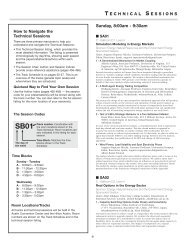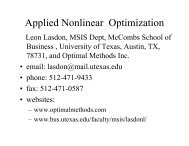Sunday
Sunday
Sunday
Create successful ePaper yourself
Turn your PDF publications into a flip-book with our unique Google optimized e-Paper software.
SB25<br />
■ SB25<br />
25- West 213 B- CC<br />
Radiation Therapy Treatment Planning I<br />
Sponsor: Health Applications Society<br />
Sponsored Session<br />
Chair: Edwin Romeijn, Professor, University of Michigan, IOE<br />
Department, 1205 Beal Avenue, Ann Arbor, MI, 48109-2117,<br />
United States of America, romeijn@umich.edu<br />
1 - A Column-generation-based Technique for Multi-criteria Direct<br />
Aperture Optimization<br />
Ehsan Salari, Research Associate, Massachusetts General Hospital<br />
and Harvard Medical School, Francis H Burr Proton Therapy,<br />
55 Fruit Street, Boston, MA, 02114, United States of America,<br />
salari.ehsan@mgh.harvard.edu, David Craft, Jan Unkelbach<br />
Multi-criteria optimization (MCO) has proved to be a promising approach to<br />
radiation therapy treatment planning. MCO is typically employed in the Fluencemap<br />
optimization stage to find a Pareto-optimal solution that yields the desired<br />
trade-off between treatment evaluation criteria. In this study we investigate the<br />
extension of the MCO approach to the direct aperture optimization problem and<br />
develop heuristics to obtain a collection of apertures that can approximate the<br />
Pareto surface.<br />
2 - Determining Convex Objective Functions and Importance<br />
Factors in Multi-criteria IMRT Planning<br />
Taewoo Lee, University of Toronto, 5 King’s College Road, Toronto,<br />
Canada, taewoo.lee@utoronto.ca, Michael Sharpe, Timothy Chan,<br />
Tim Craig<br />
In multi-criteria optimization, objective function parameters are often determined<br />
by a trial-and-error process. Multi-criteria IMRT planning typically involves many<br />
objective functions, which leads to a large parameter space to search over. We<br />
develop an inverse optimization method to determine convex objective functions<br />
and parameters that are most critical in treatment planning. Results show the<br />
potential to both streamline the planning process and increase the treatment<br />
effectiveness.<br />
3 - The Effect of Tumor Repopulation on Fractionation Schedules in<br />
Radiation Therapy<br />
Jagdish Ramakrishnan, Massachusetts Institute of Technology, 77<br />
Massachusetts Avenue, Cambridge, MA, United States of America,<br />
jagdish@mit.edu, David Craft, Thomas Bortfeld, Jan Unkelbach,<br />
John N. Tsitsiklis<br />
We consider optimizing the fractionation schedule and the number of treatment<br />
days for radiation therapy. The tumor control probability is maximized subject to<br />
a constraint on the normal tissue complication probability. We consider both<br />
exponential and gompertzian tumor repopulation between treatment fractions in<br />
the linear-quadratic formalism. Such a framework provides insights as to which<br />
types of treatment protocols (e.g., hypo-fractionation) are beneficial for various<br />
disease sites.<br />
4 - A Method for Improving the Dose Distribution Quality of<br />
Multi-criteria Radiation Therapy Plans<br />
Rasmus Bokrantz, KTH Royal Institute of Technology, SE-100 44,<br />
Stockholm, Sweden, bokrantz@kth.se<br />
This talk considers an approach to radiation therapy planning where possible<br />
treatment options are explored through realtime interpolation over precomputed<br />
solutions. A method is presented that improves the quality of interpolated<br />
solutions by minimizing a projective distance to the nondominated frontier under<br />
constraints on maintained dose distribution quality. Also, minimization of dose<br />
changes during conversion into deliverable machine settings are discussed in view<br />
of the presented method.<br />
■ SB26<br />
26- North 221 A- CC<br />
Emerging Topics in Supply Chain Management<br />
Sponsor: Manufacturing & Service Oper Mgmt<br />
Sponsored Session<br />
Chair: Li Chen, Assistant Professor, Duke University, 100 Fuqua Drive,<br />
Durham, NC, 27708, United States of America, li.chen@duke.edu<br />
1 - Integrating Inventory Replenishment and Cash Payment<br />
Decisions in Supply Chains<br />
Wei Luo, Duke University, 100 Fuqua Drive, Durham, NC,<br />
United States of America, wei.luo@duke.edu, Kevin Shang<br />
We provide a modeling framework that integrates financial flows into a two-stage<br />
supply chain where each location procures inventory based on cash available. We<br />
consider different payment schemes and derive joint optimal and near-optimal<br />
INFORMS Phoenix – 2012<br />
88<br />
inventory and cash policies. Our study demonstrates that an effective cash<br />
payment policy can mitigate the supply disruption risk and improve the overall<br />
supply chain efficiency.<br />
2 - On the Profitability of an Eco-Friendly Supply Chain<br />
Yang Li, PhD Student, Duke University, 100 Fuqua Drive,<br />
Durham, NC, 27708, United States of America,<br />
yang.li2@duke.edu, Fernando Bernstein, Kevin Shang<br />
We study a two-stage supply chain for eco-friendly problems. The production<br />
technology for eco-friendly products is more costly, but these products use<br />
components with less fossil-fuel content than regular products. In particular, ecofriendly<br />
products are less exposed to the price volatility of petroleum. We<br />
examine scenarios in which eco-friendly products are more profitable.<br />
3 - Competitive Quality Choice and Remanufacturing<br />
Adem Orsdemir, Kenan Flagler Business School, University of<br />
North Carolina, Chapel Hill, NC, 27599, United States of America,<br />
adem_orsdemir@kenan-flagler.unc.edu, Eda Kemahlioglu Ziya,<br />
Ali Parlakturk<br />
We consider an Original Equipment Manufacturer who faces competition from an<br />
Independent Remanufacturer. We explicitly characterize how OEM competes<br />
with IR in equilibrium. IR’s entry threat as well as its entry can decrease<br />
consumer and social surplus. We show either weak IR or strong IR is desirable for<br />
reducing the environmental impact. Comparing our results with benchmarks in<br />
which OEM remanufactures suggests that encouraging IRs to remanufacture in<br />
lieu of OEMs may not benefit environment.<br />
4 - Fixing Phantom Stockouts: A POS-Based Shelf Inspection<br />
Model<br />
Li Chen, Assistant Professor, Duke University, 100 Fuqua Drive,<br />
Durham, NC, 27708, United States of America, li.chen@duke.edu<br />
”Phantom stockout” is a retail stockout phenomenon caused by shelf execution<br />
failure and/or product shrinkage (e.g., theft and spoilage). In this paper, we<br />
propose a simple but effective partially-observable Markov decision process<br />
(POMDP) model to tackle this problem. We show that the optimal shelf<br />
inspection policy is a threshold policy based on the number of consecutive zerosales<br />
periods. We further extend the analysis to models with time-varying<br />
parameters.<br />
■ SB27<br />
27- North 221 B- CC<br />
Supply Chain Models with Multi-sourcing and<br />
Information Updates<br />
Sponsor: Manufacturing & Service Oper Mgmt<br />
Sponsored Session<br />
Chair: Eylem Tekin, Instructional Associate Professor, University of<br />
Houston, Department of Industrial Engineering, Houston,<br />
United States of America, etekin@central.uh.edu<br />
1 - Inventory Replenishment and Demand Allocation Decisions for<br />
Multi-Sourced Items<br />
Abhilasha Katariya Prakash, PhD Student, Texas A&M University,<br />
503 nagle st, apt 102, college station, TX, 77840, United States of<br />
America, abhilashapk@neo.tamu.edu, Eylem Tekin, Sila Cetinkaya<br />
We consider a manufacturer using multi-sourced parts from a contractual vendor<br />
(CV) and a spot market (SM). The CV holds inventory at a vendor managed hub<br />
and charges a fixed unit price under a quantity commitment contract. Inventory<br />
procured from the SM with volatile prices is held at an advance purchase hub.<br />
The overall problem deals with when and how much to order from each source<br />
and how to allocate demand to the alternative hubs.<br />
2 - Dynamic Inventory Replenishment Decisions with Bayesian<br />
Learning of Supply Yield Uncertainty<br />
Baykal Hafizoglu, Arizona State University, 699 S Mill Avenue,<br />
Tempe, AZ, 85281, United States of America, baykal@asu.edu,<br />
Sibel Salman, Esma Gel<br />
We consider a periodic-review inventory replenishment problem with yield<br />
uncertainty, where the quantity that the supplier ships in response to an order is<br />
random. We assume that the parameters that govern the supplier’s yield are not<br />
known with certainty in advance. We propose a Bayesian updating scheme that<br />
learns supplier’s yield parameters over time. We compare performance of<br />
Bayesian learning scheme with other strategies such as safety stock policy, and<br />
simple heuristics.



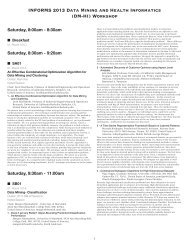
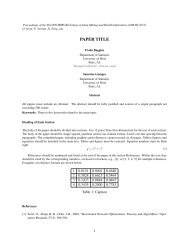
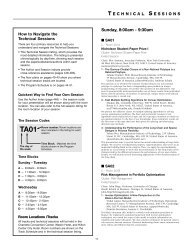
![[PDF] Charlotte Back Matter](https://img.yumpu.com/17933057/1/190x245/pdf-charlotte-back-matter.jpg?quality=85)

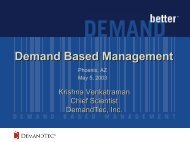
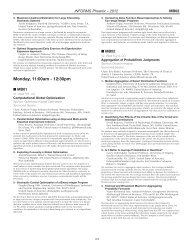
![[PDF] ALIO Back Matter](https://img.yumpu.com/17932960/1/190x245/pdf-alio-back-matter.jpg?quality=85)
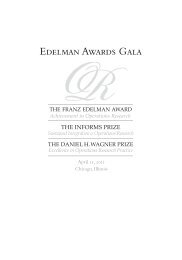
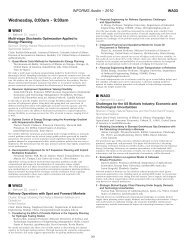
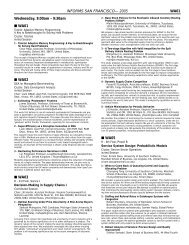
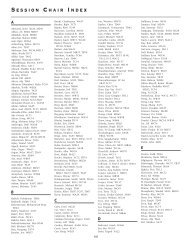
![[PDF] Monday, 8:00am - 9:30am](https://img.yumpu.com/17932954/1/190x245/pdf-monday-800am-930am.jpg?quality=85)
